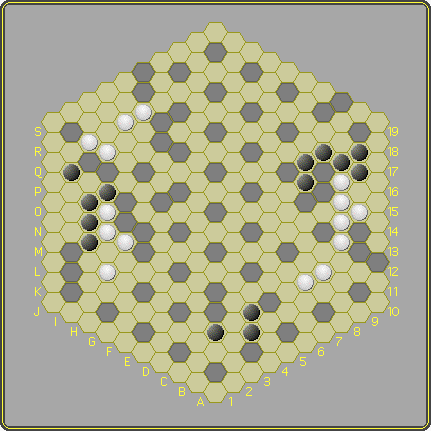- The Medusa board is a hex grid with holes to reduce the number of liberties to the number of Go: 4 in the inside area, 3 on the edge and 2 in the the corners. In XiaGo the holes are movable neutral pieces that take away liberties and make that the number of them for any cell may vary during the game. There are 7, 19, 37 or 61 of them, depending on the size of the board, and collectively they reduce the average number of liberties that a hex grid has.
- Unlike Medusa, there's no movement of groups, only of neutrals.
- Medusa's artificial safety mechanism, the 'rosette', has been omitted.
Play XiaGo interactively
 | Rules
|
Death, eternal life and suicide
A 'group' is a whole set of connected stones of the same colour. A single is a group by definition. The 'liberties' of a group are the adjacent vacant cells.
- A group dies if it loses its last liberty.
- If an opponent's group loses its last liberty by movement of a neutral piece, then this group is dead and taken from the board. After that the mandatory placement must still follow.
- If an opponent's group loses its last liberty by placement of a stone, then this group is dead and taken from the board.
- Suicide is illegal, therefore the movement of a neutral piece may not take the last liberty of one of the moving player's own groups, unless it is a capture that results in at least one new liberty for such a group.
- On the same note, the placement of a stone may not take the last liberty of one of the moving player's own groups, unless it is a capture that results in at least one new liberty for such a group.
Seki
Positions are possible wherein opposing groups exert a mutual stranglehold in which neither can attack without being killed in the attempt.
Object and counting
The game ends after two successive passes, after which the score is established. A player gets one point for every stone of his colour on the board, and one point for every vacant cell that is only surrounded by stones of his colour and/or other free cells or neutral pieces.
Komi
Komi are points awarded to the second player beforehand, to compensate for going second. In XiaGo komi has provisionally been set at 2.5 points (base-4 and -6) or 4.5 points (base-8 and -10).
How I invented ... XiaGo
XiaGo © MindSports
